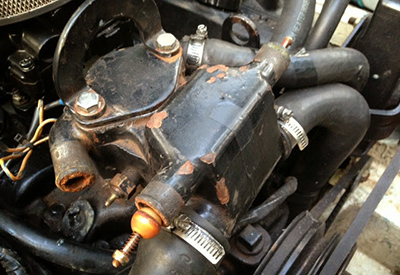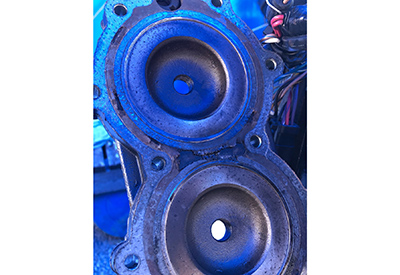Ask Andrew: High temperatures – and not just because it’s August

Aug 13, 2020
A thermostat housing on the front on a Mercruiser engine
July and August in Canada are the months of boating. People are on the water – exploring, cruising, fishing, voyaging and racing. Maintenance and repairs aren’t the priority – the fun is.
Nothing ruins the fun faster than watching the temperature gauge on your engine rise and not come down. Fear and anxiety mix – forefront in your thoughts will be “How do I get safely back to dock?”, followed quickly by ‘How bad is the damage, and how much will it cost?’
The next day, my phone rings: ‘I need a new impeller’. But 99% of the time, the impeller hasn’t been removed or inspected to determine whether it should be replaced.
Lets pause for a moment, in an effort to understand rather than assume. Let’s look at the whole system, and diagnose an overheat methodically.
 A diagram showing the pick-up and impeller locations on a Mercury Alpha stern-drive unit
A diagram showing the pick-up and impeller locations on a Mercury Alpha stern-drive unit
At the surface level, the cooling system is really simple, and it functions essentially the same way in inboards, stern-drives and outboards: water surrounding the boat enters the engine via a through-hull or through the pick-up in the stern-drive unit or the outboard.
Water is sucked up into the engine via the turning of an impeller – a series of vanes working much like a paddle-wheel. Water is then pushed through the lower part of the engine, past critical areas. When the engine is still warming up, much of this water is forced through the engine and then out through the exhaust, into the lake/ocean. As the engine’s temperature rises, the engine’s thermostat opens and allows water to flow through other parts of the engine. The engine will cool slightly, the thermostat will close until the temperature rises again.
The cooling water runs via rubber hoses, through pumps, impeller housings, small passages in the heart of the engine, then out through exhaust ports and rubber boots. There’s lots of places for the things to go wrong. Here’s a few:
- A blockage in the pick-up.
- Pick-ups aren’t underwater.
- The seacocks are closed.
- Hose leaks.
- The impeller is worn.
- The thermostat is blocked.
- Hoses are blocked.
- Broken Belts.
- Damaged circulation pump.
 A blown head gasket due to an overheat
A blown head gasket due to an overheat
As you can see – a comprehensive list. A mechanic will work their way through the system methodically, from pick-up to the exhaust, exploring each part of the system in turn until they discover the cause. Sometimes this involves flushing the engine with water, or using clear hoses to watch the water flow through each section.
If you see the temperature rise, slow the engine down if safely possible. An engine running at slower speeds has less friction, producing less heat. Try to determine why the engine is overheating: is there a blockage that can be fixed on the water? Or, is water not flowing because of a damaged impeller or pump?
A few rules of thumb:
- If water is flowing OUT of the engine, then it must be flowing IN. Check the exhaust for water flow
- You have to see or feel water to know if it’s flowing. Feel the hoses – they should be cold as seawater flows through them. If you can’t tell, remove hoses and replace them with clear hoses to watch where/how water moves
- Impellers are relatively cheap, but getting to them can be tough. Before buying an impeller, make sure that a replacement is needed, and that you have a plan to take care of it
- If your engine has overheated, have the engine checked over. Depending on the severity, an overheated engine can cause hoses, sensors, wires and boots to melt. They can even cause metal components to warp, necessitating costly rebuilds.
- Keep your temperature gauge in working order, and keep a close eye on it when the engine is running.
 Andrew McDonald is the owner of Lakeside Marine Services – a boat repair/maintenance firm based in Toronto. Andrew has worked in the marine industry for 12 years and is a graduate of the Georgian College ‘Mechanical Techniques – Marine Engine Mechanic’ program.
Andrew McDonald is the owner of Lakeside Marine Services – a boat repair/maintenance firm based in Toronto. Andrew has worked in the marine industry for 12 years and is a graduate of the Georgian College ‘Mechanical Techniques – Marine Engine Mechanic’ program.
Questions or comments for Andrew? Email him directly via: askandrew@lakesidemarineservices.ca




























